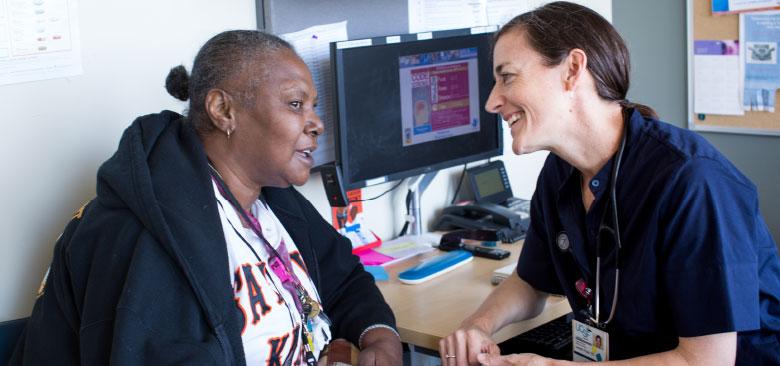
Nurse practitioner Janeen Rojas with a patient (photos by Elisabeth Fall)
Trauma-Informed Care for Women with HIV and Beyond
Trauma-Informed Care for Women with HIV and Beyond
It has become axiomatic that effective medical treatments have turned human immunodeficiency virus (HIV) infection from a death sentence to a manageable chronic disorder. That’s the good news.
The bad news, says Carol Dawson-Rose, professor at UC San Francisco School of Nursing and a researcher at the International Center for HIV/AIDS Research and Clinical Training in Nursing, is that people with HIV are still at risk for premature death – not from their disease, but from conditions such as suicide, violence or substance use, which are often related to past or current physical or psychological trauma.
At the Women’s HIV Program at UCSF (WHP), Dawson-Rose and her colleagues are using a research-based model known as trauma-informed primary care to interrupt cycles of violence, addiction and mental health challenges, and to address structural trauma such as racism and poverty, in order to help improve the lives and health of women living with HIV.
A Wake-Up Call
Several large-scale studies have demonstrated significant links between childhood and adult trauma and serious health problems like heart disease, cancer, depression and diabetes. Until a few years ago, however, HIV care was almost entirely focused on reducing viral loads and strengthening immune system responses to the infections that typically threaten the health of people living with HIV. Patients had low levels of virus, and relatively few suffered serious consequences from the infections that typically threaten the health of people with HIV. Nevertheless, patients continued to suffer from lack of housing, substance use and mental health challenges.
The 2010 murder of a patient by her husband served as a wake-up call that other outcome measures (besides HIV viral load) were important to the health and well-being of patients. Although the woman’s death ostensibly had nothing to do with HIV care, the WHP’s director, Edward Machtinger, called on his colleagues to examine what they might have done differently to prevent the tragedy. Their review of 10 years of clinic data revealed that an astounding 84 percent of patient deaths were related, directly or indirectly, to trauma.
Alarmed and intrigued, Machtinger led a pair of studies that suggested that women with HIV have disproportionate rates of trauma exposure and recent post-traumatic stress disorder (PTSD), and that recent trauma is associated with HIV treatment failure and risky HIV-related behaviors.
“HIV [care] has been very focused on the biomedical model, on getting people to medication and getting them to undetectable viral load,” says Dawson-Rose. “Medication is amazing, but there’s a whole other piece to health that isn’t being addressed.”
Changing the Model to Change Outcomes
 Carol Dawson-Rose Dawson-Rose, who has spent the past two decades researching and teaching other clinicians about the connection between HIV and behavioral health, had first worked with Machtinger on a project with Rhodessa Jones, director of the Medea Project: Theater for Incarcerated Women. The project used theater-based group workshops, culminating in public performances, to help women living with HIV disclose their status. The project resulted in a paper, co-authored by Machtinger, Dawson-Rose and their colleagues, published in the Journal of the Association of Nurses in AIDS Care. Based on that experience, Dawson-Rose was eager to work with Machtinger again to find ways to ameliorate the effects of trauma on the women WHP serves.
Carol Dawson-Rose Dawson-Rose, who has spent the past two decades researching and teaching other clinicians about the connection between HIV and behavioral health, had first worked with Machtinger on a project with Rhodessa Jones, director of the Medea Project: Theater for Incarcerated Women. The project used theater-based group workshops, culminating in public performances, to help women living with HIV disclose their status. The project resulted in a paper, co-authored by Machtinger, Dawson-Rose and their colleagues, published in the Journal of the Association of Nurses in AIDS Care. Based on that experience, Dawson-Rose was eager to work with Machtinger again to find ways to ameliorate the effects of trauma on the women WHP serves.
In 2015, funded by a UCSF Resource Allocation Program grant, Dawson-Rose and her colleagues conducted in-depth interviews with patients, looking at the various types of trauma they’d been exposed to throughout their lives. They also interviewed clinic staff and collaborators in the community, like case managers and mental health providers, to understand the impact of patients’ trauma and its contribution to poor outcomes, as well as their own experiences and ability to care for patients with high levels of trauma.
Ultimately, the WHP team decided they needed to build on their medical home model, where primary care is integrated into the delivery of HIV services. They sought to create a safe space for patients to address problems from lifelong exposure to trauma and to work on healing and treating their trauma exposure as an essential part of their health care.
Today, all staff undergo specialized training that addresses the link between trauma and health, the impact of trauma on patient behaviors, implicit bias and self-care. The training has led to significant changes in how the WHP delivers care.
For example, when a now-routine screening identifies a patient with PTSD symptoms, the patient may be quickly referred to on-site psychotherapy and trauma recovery support; at the same time, WHP clinicians might collaborate with UCSF’s Trauma Recovery Center for additional interventions and to connect patients to other community-based services. In cases of substance abuse connected to trauma, clinicians don’t stop at counseling patients to quit and connecting them to resources, but might also offer medication-assisted treatment, such as opiate-replacement therapy, which can be managed at the WHP. It’s a harm reduction model, designed to address the substance use while simultaneously facilitating healing from trauma.
Creating a Trauma-Informed Care Framework
Incorporating trauma-informed care across the primary care spectrum has the potential to improve the health of a large segment of the population, not just those living with HIV. A large-scale study conducted by the Centers for Disease Control and Prevention (CDC) with Kaiser Permanente, which classified adverse childhood experiences into seven categories, found that nearly two-thirds of participants had experienced traumatic childhood events in at least one category, while one in five had experienced traumatic childhood events in three or more categories.
Dawson-Rose, Machtinger and their colleagues have been collecting data on their efforts since they began implementing the trauma-informed care model, and are using their experiences to inform national efforts to implement trauma-informed care.
In 2013, WHP partnered with Positive Women’s Network-USA (PWN-USA) to convene a group of 27 trauma experts, policymakers and other stakeholders. The goal was to examine evidence-based strategies and come up with a framework for implementing trauma-informed primary care.
The group shared their insights in a 2015 paper in Women's Health Issues titled “From Treatment to Healing: The Promise of Trauma-Informed Primary Care.” Machtinger, Dawson-Rose, the School of Nursing’s Yvette Cuca, the School of Medicine’s Leigh Kimberg and PWN-USA’s Naina Khanna authored the piece, which lays out the case for trauma-informed primary care and outlines a framework based, in part, on the WHP experience.
The paper advises an incremental approach, and describes several first steps informed by the successes of WHP, including extensive staff training on trauma, identification of champions to help facilitate changes and identifying community partners to extend care beyond the clinic.
The essential thing for clinicians to remember, says Dawson-Rose, is that health is more than what can be measured in viral loads, blood sugar or cholesterol levels. It encompasses challenges and traumas from our pasts and those we encounter every day. She says, “People leave the clinic and go out into a world where inequalities, where racism and community-level crime exist. We can have the best care in the country, but to really help people, we have to ask, ‘What else is going on here?’”



